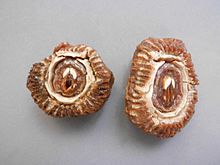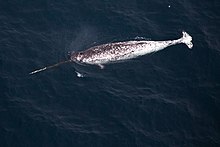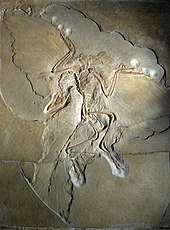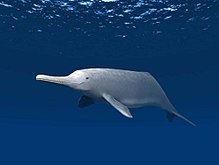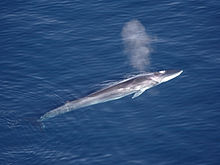The Cetaceans Portal

Cetacea (/sɪˈteɪʃə/; from Latin cetus 'whale', from Ancient Greek κῆτος (kêtos) 'huge fish, sea monster') is an infraorder of aquatic mammals belonging to the order Artiodactyla that includes whales, dolphins and porpoises. Key characteristics are their fully aquatic lifestyle, streamlined body shape, often large size and exclusively carnivorous diet. They propel themselves through the water with powerful up-and-down movement of their tail which ends in a paddle-like fluke, using their flipper-shaped forelimbs to maneuver.
While the majority of cetaceans live in marine environments, a small number reside solely in brackish water or fresh water. Having a cosmopolitan distribution, they can be found in some rivers and all of Earth's oceans, and many species inhabit vast ranges where they migrate with the changing of the seasons.
Cetaceans are famous for their high intelligence, complex social behaviour, and the enormous size of some of the group's members. For example, the blue whale reaches a maximum confirmed length of 29.9 meters (98 feet) and a weight of 173 tonnes (190 short tons), making it the largest animal ever known to have existed.
There are approximately 89 living species split into two parvorders: Odontoceti or toothed whales (containing porpoises, dolphins, other predatory whales like the beluga and the sperm whale, and the poorly understood beaked whales) and the filter feeding Mysticeti or baleen whales (which includes species like the blue whale, the humpback whale and the bowhead whale). Despite their highly modified bodies and carnivorous lifestyle, genetic and fossil evidence places cetaceans as nested within even-toed ungulates, most closely related to hippopotamus within the clade Whippomorpha. (Full article...)
Selected picture

Dolphins have a streamlined fusiform body, adapted for fast swimming. The tail fin, called the fluke, is used for propulsion, while the pectoral fins together with the entire tail section provide directional control. The dorsal fin, in those species that have one, provides stability while swimming.
More did you know...

- ...that while the main predators of the Harbour Porpoise are Great white sharks and Orcas, Bottlenose Dolphins have been witnessed attacking and killing porpoises in response to a lessing food supply.
- ...Aboriginal whalers are permitted to hunt cetaceans, despite the IWC's memorandum on commercial hunting.
- ...the melon is an oval shaped oily, fatty lump of tissue found at the centre of the forehead of most dolphins and toothed whales, located between the blowhole and the end of the head.
- ...the Spinner Dolphin is so called because of its acrobatic displays in which they will spin longitudinally along their axis as they leap through the air.
- ...that the Tay Whale was a Humpback whale unlucky enough to be spotted near Dundee, Scotland, then the UK's premier whaling port, in early December, 1883.
Things you can do..
|
|
Here are some Cetaceans WikiProject tasks you can do.
|
General images -
Did you know (auto-generated)

- ... that the South Asian river dolphin is nearly blind and relies on echolocation for navigation?
- ... that one can swim with humpback whales in the Niue Nukutuluea Multiple-Use Marine Park?
- ... that Celia Kaye won the Golden Globe Award for Most Promising Newcomer in 1965 for her starring role in Island of the Blue Dolphins?
- ... that one of the first researchers to propose dolphin-assisted therapy for humans later renounced it?
Selected media
List articles
Related portals
WikiProjects

The content you are reading was created by Wikipedia volunteers. See WikiProject Cetaceans for more.
- See also: Wikispecies, a Wikimedia project dedicated to the classification of species.
Cetacean articles
Categories
For additional lists of marine life-related featured articles and good articles see:
Associated Wikimedia
The following Wikimedia Foundation sister projects provide more on this subject:
-
Commons
Free media repository -
Wikibooks
Free textbooks and manuals -
Wikidata
Free knowledge base -
Wikinews
Free-content news -
Wikiquote
Collection of quotations -
Wikisource
Free-content library -
Wikispecies
Directory of species -
Wikiversity
Free learning tools -
Wikivoyage
Free travel guide -
Wiktionary
Dictionary and thesaurus
![Image 1 Sei whale mother and calf The sei whale (/seɪ/ SAY, Norwegian: [sæɪ]; Balaenoptera borealis) is a baleen whale. It is one of ten rorqual species, and the third-largest member after the blue and fin whales. It can grow to 19.5 m (64 ft) in length and weigh as much as 28 t (28 long tons; 31 short tons). Two subspecies are recognized: B. b. borealis and B. b. schlegelii. The whale's ventral surface has sporadic markings ranging from light grey to white, and its body is usually dark steel grey in colour. It is among the fastest of all cetaceans, and can reach speeds of up to 50 km/h (31 mph) over short distances. It inhabits most oceans and adjoining seas, and prefers deep offshore waters. It avoids polar and tropical waters and semi-enclosed bodies of water. The sei whale migrates annually from cool, subpolar waters in summer to temperate, subtropical waters in winter with a lifespan of 70 years. It is a filter feeder, with its diet consisting primarily of copepods, krill, and other zooplankton. It is typically solitary or can be found in groups numbering half a dozen. During the breeding period, a mating pair will remain together. Sei whale vocalizations usually lasts half a second, and occurs at 240–625 hertz. (Full article...)](http://upload.wikimedia.org/wikipedia/en/d/d2/Blank.png)

